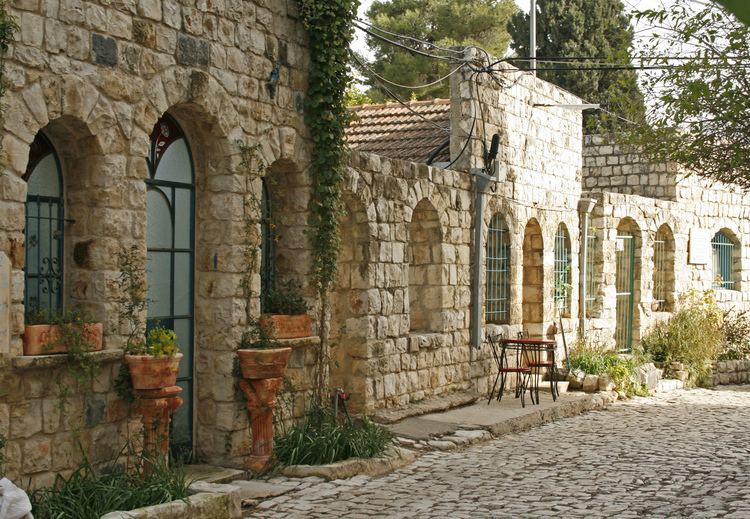Founded 1882 Local time Thursday 1:19 AM | Area 18 km² Population 2,906 (2014) Number of airports 1 | |
 | ||
Weather 13°C, Wind N at 3 km/h, 74% Humidity Points of interest Tel Hazor, HaBaron Garden, Tel Hazor National Park ‑ גן ל | ||
Sfl episode 1 rosh pinna found an abandoned hostel
Rosh Pina (Hebrew: רֹאשׁ פִּנָּה, lit. Cornerstone) is a town and local council in the Upper Galilee on the eastern slopes of Mount Kna'an in the Northern District of Israel. The town with the current name was founded in 1882 by thirty families who immigrated from Romania, making it one of the oldest Zionist settlements in Israel. It was preceded at the same location by the settlement of Gei Oni ("Valley of My Strength"), established by local Jews from Safed in 1878, which had been, however, almost fully abandoned by 1882. In 2015 it had a population of 2,908.
Contents
- Sfl episode 1 rosh pinna found an abandoned hostel
- Map of Rosh Pinna Israel
- Geography
- History
- Discovery of wild emmer
- Education
- Transportation
- Medical facilities
- Landmarks
- Notable residents
- References
Map of Rosh Pinna, Israel
Geography
Rosh Pina is located north of the Sea of Galilee, on the eastern slopes of Mount Kna'an, approximately 2 km (1 mi) east of the city of Safed, 420 m (1,378 ft) above sea level, latitude north 32° 58', longitude east 35° 31'. North of Rosh Pina is Lake Hula, which was a swamp area drained in the 1950s.
History
Rosh Pina was one of the first modern Jewish agricultural settlements in history of the Land of Israel, then part of the Turkish Ottoman Empire. Rosh Pina was established near the Arab village of al-Ja'una. In 1883, it became the first Jewish settlement in the Land of Israel to come under the patronage of the Baron Edmond James de Rothschild.
Gei Oni was founded in 1878 by Jews from Safed, some of whom were descended from Spanish Jews exiled in 1492. However, most of the original two to three dozen families left after three years of drought, though three families remained: Keller, Friedman, and Schwartz. A year later, in 1882, a group of Romanian Jews, most of them coming from Moineşti in Moldavia, and led by Moshe David Shuv, joined the three families of Gei Oni, enlarged the village, and renamed it Rosh Pina, as per Psalm 118:22: "The stone which the builders rejected has become the cornerstone [lit. "head of the corner", i.e. "rosh pina" in Hebrew]."
Moshe David Shuv (born 1854 in Moineşti; died 1938 in Jerusalem) had been sent ahead to find and purchase an appropriate piece of land for the colonists. Born as Moşe David Iancovici, in Palestine he became known as שו"ב, Shuv, a Hebrew abbreviation of the name of his profession, שוחט ובודק, read "shochet ve-bodék", butcher and examiner [of kosher meat]; "shuv" has the Hebrew meaning of "once again" or "return!", an allusion to the main principle of Zionism.
Laurence Oliphant collected funds for the settlement from Christadelphians and other sympathizers in Britain. He wrote about his visit to Rosh Pina in 1886:
"Jauna, which was the name of the village to which I was bound, was situated about three miles (5 km) from Safed, in a gorge, from which, as we descended it, a magnificent view was obtained over the Jordan valley, with the Lake of Tiberias lying three thousand feet below us on the right, and the waters of Merom, or the Lake of Huleh, on the left. The intervening plain was 3. rich expanse of country, only waiting development. The new colony hall been established about eight months, the land having been purchased from the Moslem villagers, of whom twenty families remained, who lived on terms of perfect amity with the Jews. These consisted of twenty-three Roumanian and four Russian families, numbering in all one hundred and forty souls. The greater number were hard at work on their potato-patches when I arrived, and I was pleased to find evidences of thrift and industry. A row of sixteen neat little houses had been built, and more were in process or erection. Altogether this is the most hopeful attempt at a colony which I have seen in Palestine. The colonists own about a thousand acres of excellent land, which they were able to purchase at from three to four dollars an acre. The Russians are establishing themselves about half a mile from the Roumanians, as Jews of different nationalities easily get on well together. They call the colony Rosch Pina, or "Head of the Corner," the word occurring in the verse, "The stone which the builders rejected, the same is become the head of the comer."
Eventually the village had to be saved financially by Baron Edmond James de Rothschild, who then imposed his economic concept on the colonists.
According to a census conducted in 1922 by the British Mandate authorities, Rosh Pinna had a population of 468 inhabitants, consisting of 460 Jews, 4 Muslims and 4 Christians.
Discovery of wild emmer
Botanist Aaron Aaronsohn, while trekking around Rosh Pina during his 1906 field trip, discovered wild-growing emmer (Triticum dicoccoides), whom he considered to be the "mother of wheat", an important find for agronomists and historians of human civilization. Geneticists have proven that wild emmer is indeed the ancestor of most domesticated wheat strands cultivated on a large scale today with the exception of durum wheat; einkorn, a different ancient species, is currently just a relict crop.
Education
Rosh Pina had the first Hebrew School in 1899.
Transportation
Ben Ya'akov Airport is located 2.1 km (1 mi) away from Rosh Pina.
Medical facilities
The Mifne Center, which means turning point, a program for the treatment of autism spectrum disorder, is situated in Rosh Pina.
